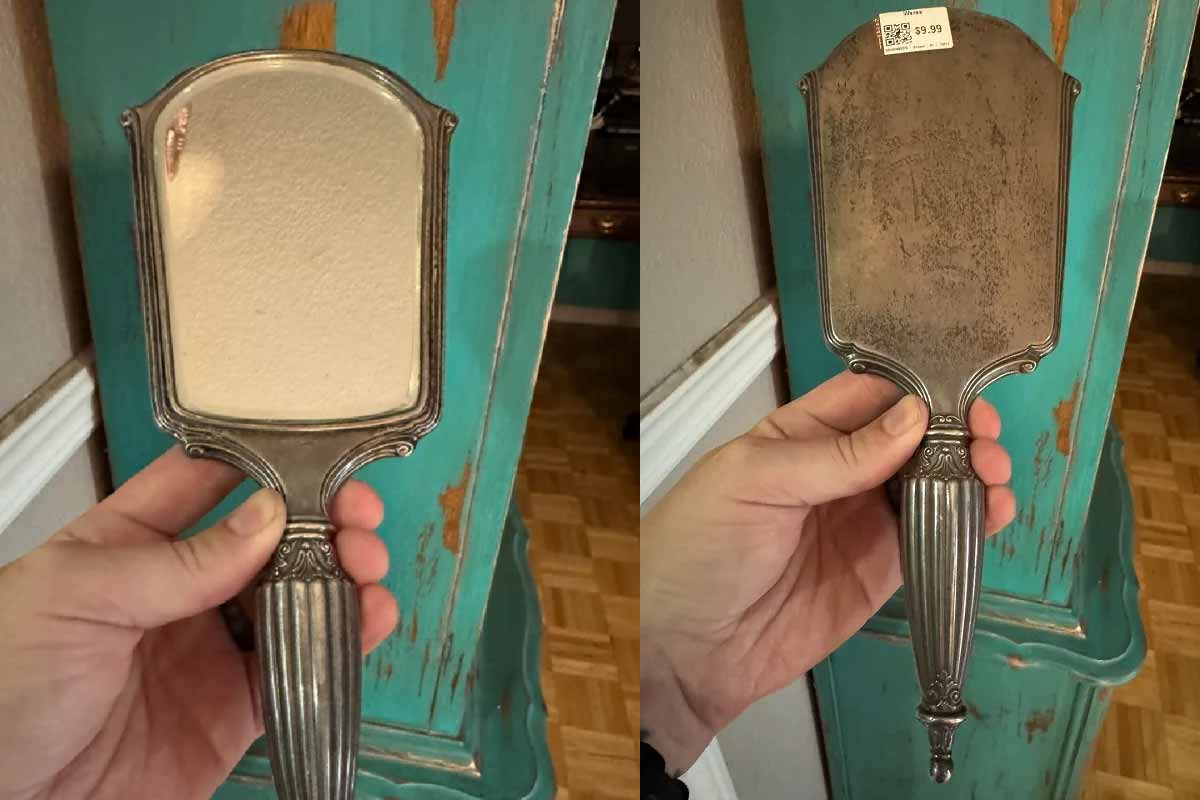A shine on a dusty shelf stopped him cold. In a Reno Goodwill, a Nevada thrifter lifted a 1950s mirror with a silver handle. He felt a story click into place. He pictured his wife’s salon, already lined with antique beauty tools. He turned the handle and studied the metal. The weight felt right, the glow was soft, and the surface looked lived-in. Two engraved words, plus a date, soon changed the day and the plan.
From a Reno thrift shelf to a perfect gift
Alexander was browsing the aisles, as he often does. His wife loves vintage beauty pieces, so he always hunts for items with character. Her walls hold old hand trimmers, curlers, blow dryers, vanities, and other classic grooming tools. This find looked special before he even checked the price tag.
He noticed the silver handle first, then the quiet patina. That aged sheen told him the mirror might be older than the décor it joined. He grabbed it fast, because the shelf traffic felt steady. The shape suggested mid-century design. The balance felt sturdy in the hand, not flimsy.
Excitement arrived before certainty. He imagined her reaction while he walked to the counter. The label showed $9.99, which made the decision easy. A gift, yes, yet maybe more. The metal seemed real, while the details looked crisp. He paid, then planned a closer inspection at home.
Two engraved words on a sterling mirror unlocked the real story
Back at home, he examined the handle carefully. Two words appeared where the thumb rests: Webster Sterling. Nearby, a clear date read 1953. The letters were neat and crisp, as if time respected the craft. The engraving felt right for the era and the maker.
He compared the piece with listings and past auctions. Similar Webster Sterling hand pieces showed steady demand. Valuations clustered between $75 and $200, depending on condition. The range reflected surface wear, glass clarity, and pattern. While values vary, those hallmarks often guide buyers and sellers toward a fair call.
As the facts settled, joy did too. He confirmed the metal was sterling, not plated, and that the glass sat snug in the frame. The mirror had lived, yet it was sound. He liked the weight, the grip, and the story behind the date. The find seemed real and right.
Why thrifting still wins for timing and trained eyes
The hunt itself pays off, even before any sale. Across the U.S., more than 25,000 resale, consignment, and not-for-profit shops welcome regulars. Research also estimates thrifters save an average of $2,071 a day. That figure reflects deals that stack up because small wins add speed.
Some wins make headlines, which keeps people looking. A rare Halloween mask cost $5 in one store, then later earned over $700 on eBay. A designer garment with a $922 retail tag sold secondhand for $13. A bag of pens marked $3 turned out to be worth $100. Stories spread hope.
Method helps more than luck, though. Study hallmarks, scan frames, and watch for balanced weight. Bring a small light, because reflection reveals flaws and fixes. Check edges for gaps and chips. Ask for a return policy, even when the price feels friendly. The trained approach lifts every mirror check.
What the 1953 mirror means for collectors, sellers, and stylists
Numbers help frame the choice. Online examples place similar Webster Sterling pieces near $75 to $200. Condition matters; patina can add charm, while dents reduce appeal. Alexander pegged this one near $200, given the date, metal, and feel. Even so, the sentimental value rose faster.
Although a quick flip was possible, he chose a different return. He gave it to his wife, who plans to hang it in the salon. Customers may use it, or it may join the wall display. The piece adds texture and light. It also signals care for craft and era.
A light polish will lift the glow without erasing time. He will clean the glass, then leave the metal’s character intact. That balance fits the setting, because salons mix function and style. The mirror offers both. It brings 1953 to the present, while it anchors a space people share.
Care, display, and preservation for vintage sterling hand pieces
A gentle plan protects silver and glass. Use a soft cloth, and avoid harsh abrasives. Work slowly, because pressure can shift the frame. If needed, a mild polish can lift tarnish without stripping patina. That look records age, so treat it like history, not dirt.
Display matters almost as much as cleaning. Keep pieces away from hot lights and damp corners. Mount securely, yet allow easy removal for dusting. In a salon, positioning also guides traffic. A well-placed piece calms flow, while it adds charm. Light should flatter, not blind.
Storage rules keep value steady. Wrap in untreated tissue or a microfiber sleeve. Avoid rubber bands and sticky labels. Box it so the glass cannot rattle. Label the maker and date on the container, not the frame. Because records guide future choices, the next mirror check becomes faster and safer.
A thrift-store glint that keeps paying dividends
The day started with a casual browse and ended with a story that sticks. Two engraved words, a date, and a steady hand turned a $9.99 find into something lasting. While the market suggests $75 to $200, meaning runs deeper. This mirror now brightens work, memory, and a wall that tells time.
